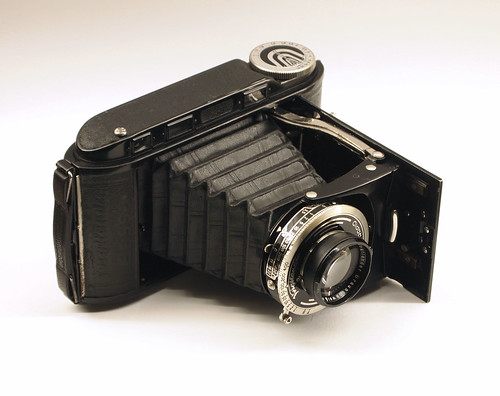 |
| Voigtländer Bessa Entfernungsmesser or Rangefinder |
The
Bessa Rangefinder or
Bessa RF (also known as the Bessa E or Bessa E Messer, from
Entfernungsmesser, the German for 'rangefinder') was introduced in 1936, one of a long-running series of
Bessa folding cameras made by
Voigtländer (the Bessa name has also been recently revived by Cosina for their Voigtländer-branded
35mm and
medium format rangefinders). It is a
6x9 folder using
120
roll film, with a mask for 6x4.5 pictures. It was available with three
different lenses, the most expensive variant carrying the
Heliar
lens, all with a hinged filter. Production of the Bessa RF was restarted after the second world war, until the model was superceded by a 1950s Bessa Rangefinder, the
Bessa II.
Having used the Bessa RF to shoot the expired Verichrome 620 film which was the subject of
my last post, I thought this would be a good opportunity to write about the camera. Voigtländer had previously produced the
Prominent, a fully-featured 6x9 rangefinder, but the rather Baroque design must have been expensive to manufacture. The Bessa design represents a complete rethink: it was based around the body of an optical-finder Bessa that Voigtländer made to replace their earlier
Inos folding cameras. One aspect that remained the same is like the Prominent, the Bessa's rangefinder also has both windows offset from the eyepiece, not a common arrangement. Unlike the Prominent, the rangefinder and viewfinder are both housed under the camera's top plate, which is uncluttered except for the focus knob. On the other end of the top plate is a small button with a ridged grip. This is used to rotate a mask hidden inside the viewfinder to narrow the view from the 6x9 format down to 6x4.5 proportions when using with the internal mask. The camera's black painted trim and other components, rounded corners and curving lines lend the Bessa RF a touch of Art Deco elegance (compare, for example, the contemporaneous
Super Ikonta, with similar features in a very different arrangement).
To open the camera there is a small release button on the bottom plate. The lens is self-erecting, although with my camera the front standard needed to be securely locked into place manually, it may have had more spring when new. The metal tab underneath the lens is depressed to unlock it and close the camera. When opened, the unusual shutter release is erected from the slot in the hinge-side of the door close to the body, shown in the image below. This shutter release trigger was a common feature to Voigtländer's folding cameras of the 1930s and 40s, and one which the company patented.
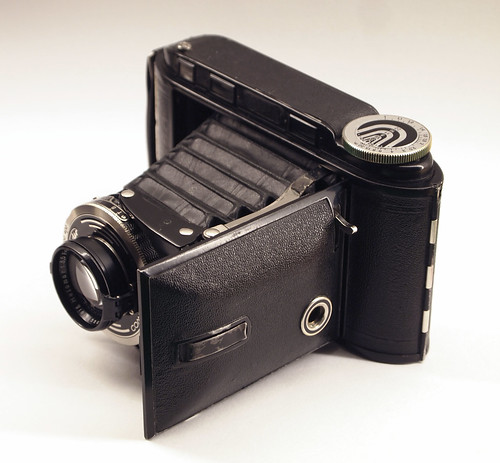 |
| Voigtländer Bessa RF |
The split image rangefinder is a separate window from the viewfinder, but it is coupled to the lens. As the rangefinder eyepiece shows a magnified and cropped image, allowing for very accurate focus, the separate viewfinder is needed for framing. Focussing is by turning the knob on the top plate which also provides a depth of field scale. This moves the whole lens and shutter unit forwards on two brass rails inside the bed. Interestingly, the camera can be focussed when closed, and as a result the focus does not have to be set to inifinity when closing the camera, unlike some rangefinders. The camera focuses down to just under 1 metre.
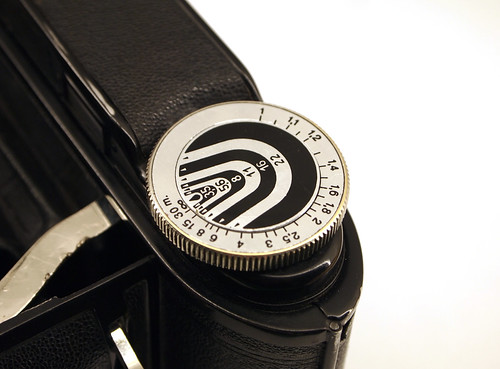 |
| Detail of focus knob and depth of field scale |
One of the curious effects of the Bessa's layout is that the user controls are on the left hand side of the camera, which makes for odd ergonomics for a right-handed person. However, I have read somewhere that the reason for this was that it designed to be used comfortably when held vertical, in the portrait format. I habitually use the 6x9 format for landscapes, but turning the camera through 90º this makes sense: the user's right hand can support the camera with either fore- or middle finder on the shutter release, while the left hand can rotate the focus wheel. In the horizontal format, one has to use the same hand to focus,
then depress the shutter. The controls around the lens are placed in such a way that these can be easy adjusted in either vertical or horizontal position when looking down at the camera. In particular, the shutter speeds are represented on two scales, visible from the front, as is standard with Compur rim-set shutters, but also just above the aperture settings on the side of the shutter.
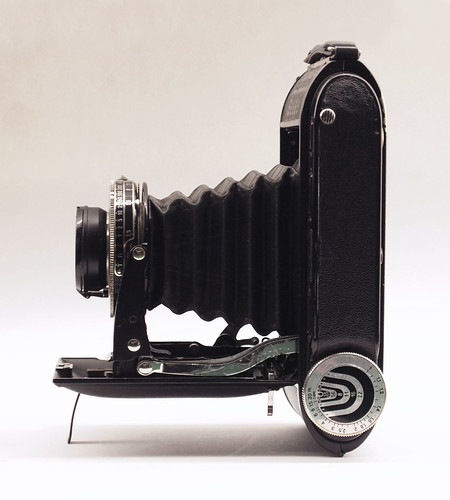 |
| Voigtländer Bessa RF in vertical format |
My camera has the Helomar f3.5 105mm lens, which was the least expensive option; the Bessa RF was also supplied with a Skopar, or, the most prized, a Heliar lens. According to
this scan of the British Journal Photographic Almanac 1939, there was a £5 difference between the bottom of the range Bessa RF with the Helomar lens, and that with the Heliar lens, which does not sound like much, but the cheapest optical-finder Bessa was just £2.17.6. The results I've had from this camera demonstrate that the Helomar lens performs as might be expected from a pre-war uncoated triplet: soft at the edges at wider apertures but still very capable of resolving fine detail in the central image area, as shown in the recent tests of
Rollei RPX 25 shot with this film; stopped down beyond f8 the Helomar is acceptably sharp, especially in relation to the size of a 6x9 negative (such as the example shot on Fomapan 400 below, possibly shot at f16). Incidentally, the lens is dated to 1936, the year the Bessa RF was introduced, although the shutter's serial number is dated two years later, to 1938.
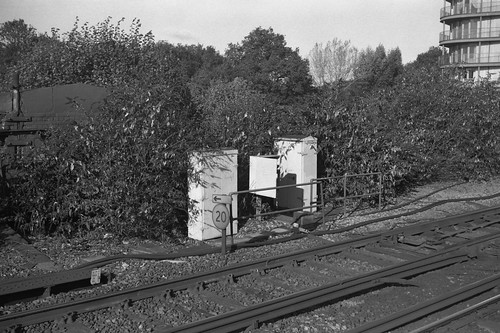 |
| Voigtländer Bessa RF sample image with Fomapan 400 |
When using the Bessa RF there are a few quirks to watch out for. My camera has seen a fair amount of use, judging from the paint losses and other signs of wear. As well as having to ensure that the lens is rigidly locked in place on opening, the shutter linkage sometimes needs to be reset: the pivoting arm which trips the release lever on the shutter has a pin connecting to a slot which descends when the shutter trigger is pressed. This pin sometimes comes loose and needs to be located back in the slot by hand. I don't know if this is a common problem with old Bessas, a weak point in the design: there does appear to be a fair bit of play with these components, which no doubt has increased with use. I also found when I first received the camera that the shutter release was not very 'soft', which meant that I had to use faster shutter speeds to ensure against camera shake, and as a consequence I had to use the lens at wider apertures to compensate. This was resolved by loosening the retaining ring inside the camera and turning the whole shutter and lens assembly by just a small amount, to reduce the distance the pivoting linkage arm has to travel to trip the shutter (existing scratches on the retaining ring were evidence that the lens and shutter had be removed at some point, and perhaps not positioned entirely right when replaced).
One of the shots on Rollei RPX 25 was hand-held at 1/50th, taken after this adjustment, which I wouldn't have been confident about previously. My Bessa is missing the yellow filter, but still has the hinged filter ring, so it may be possible to finder a filter to fit this. It is also missing the 6x4.5 mask, and I may attempt to make one to fit the camera at some point. The main reason I haven't used the Voigtländer Bessa RF more is that it is bigger and heavier than my other 6x9 folding cameras, such as the
Baldalux, and when shooting the kind of landscape or cityscape photography I typically use this format for, the ability to judge focus accurately with the rangefinder is less critical. However, I did find that it was invaluable when using 620 film due to the way the spools fit in the cradle of the supply-side, something none of my other medium format cameras are capable, with the exception of the
Lumière Scout Box.
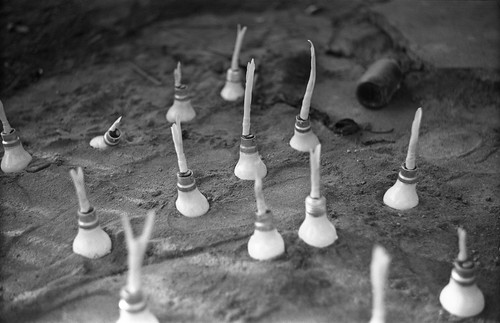 |
| Voigtlander Bessa RF, close-focussed sample image with Fomapan 400 |
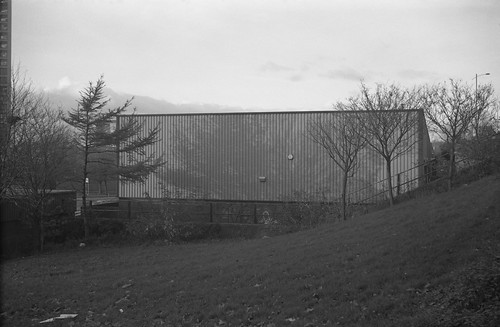 |
| Voigtländer Bessa RF sample image with HP5 Plus |
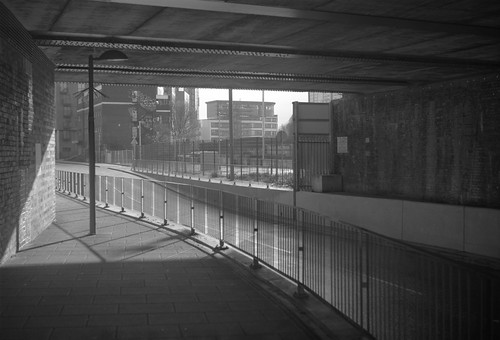 |
| Voigtländer Bessa RF sample image with Rollei RPX 400 |
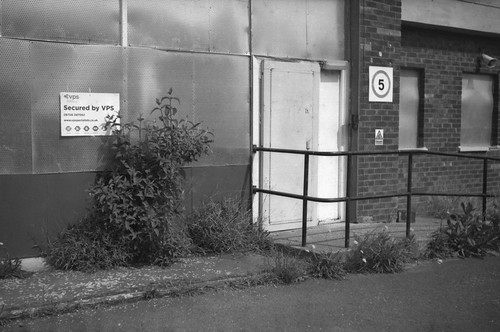 |
| Voigtländer Bessa RF sample image with expired Verichrome Pan |
 |
| Voigtländer Bessa RF sample image with Fomapan 400 |
Sources/further reading:
Bessa RF on Camera-Wiki
Early Photography's page on the Bessa RF










Hello, my focus wheel is really hard to turn, any advice to solve this problem ? maybe put some oil but I don't know if/how I should open it.
ReplyDeleteI don't know if I have any advice in particular - there's a screw underneath the focus wheel on the inside of the camera - but this might just be an adjustment for the rangefinder. Have you tried pulling the whole lens unit forward as a means to work it looser?
Delete